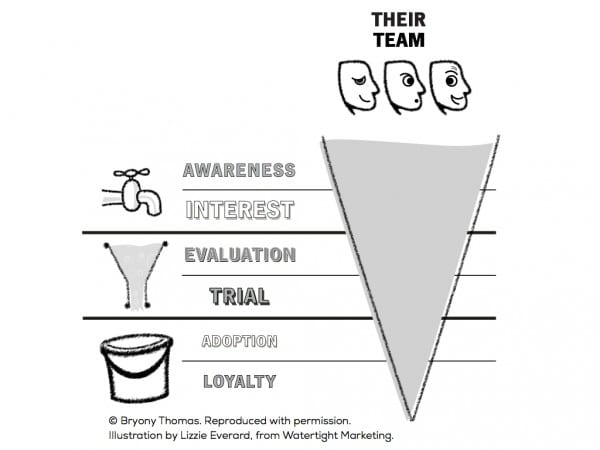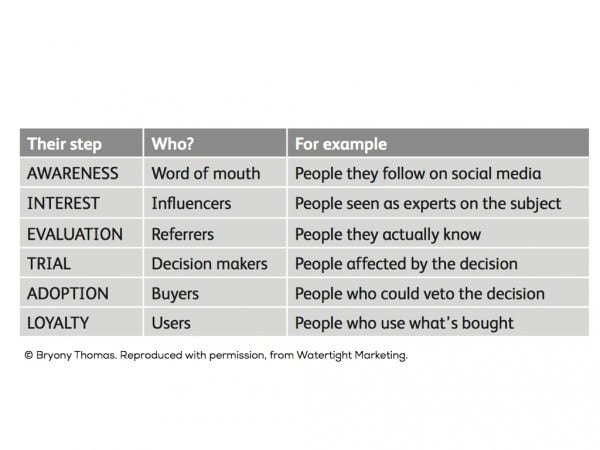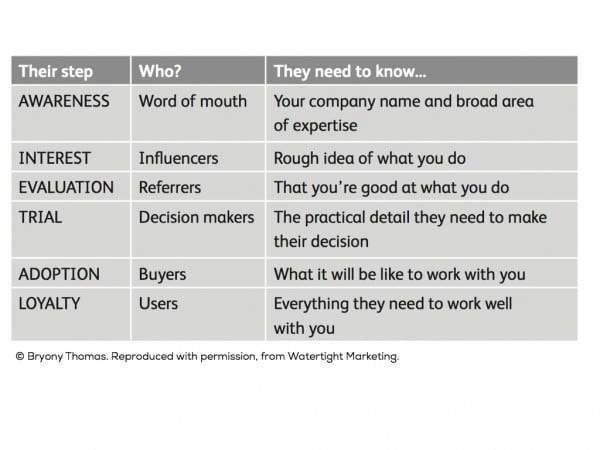What is influencer marketing and how to use it?
Buying decisions, particularly high-value or complex ones, are not made in isolation.You need to know who your buyers are talking to, and get those people on side. You need to know who’s on their team, and get them on yours. That is how I define influencer marketing. In this post I'll show how you can use it in practice by mapping third parties to the buying decision to plan your influencer marketing.
Why is influencer marketing important?
The source of a message is often as important as the message itself... The opinions of others are sought during a buying decision for two main reasons:
- people may wish to shortcut the process by asking someone they think knows the subject well,
- and secondly, they may look for reassurance that their decision is sound.
This is why you’ll hear marketers talk about including ‘influencers’ as part of your wider audience. It’s good advice. But, it’s such a broad term. Thinking about which specific people have what level of influence at each stage of the process allows you to communicate with them more precisely.
What’s interesting, and powerful in terms of your marketing, is to think about the different people buyers turn to at the different stages of their buying decision.
What you’ll typically find is that people cast the net wide in the early stages and then reduce down the people whose opinion they particularly value as they get closer to the purchase.

Who's really on the buying team?
(NB. For some businesses your users might be a larger pool. For example, a large software implementation might be bought by a small buying team but used by hundreds of people on rollout. If this is the case in your business, your sketch for their team will flare out at the bottom to look a little like an ice cream sundae glass.)
In practice the extended buying team, i.e. the third parties whose opinion is sought, involved in a considered purchase might look like this: 

At the beginning a buyer might ask around without much selectivity. As the decision draws closer, they are likely to rely on sources they really trust to help with this decision. This is partly because there’s a limit to what can be reasonably asked of friends, family and colleagues in terms of the time they’ll give to helping with the decision. But, it’s also because the opinion of some people matters more than others.
Who needs to know what?
To be able to appropriately affect your buyers’ influencers, you need to identify who they are and map them against the decision making process. This allows you to focus your attention on key people, and to work out the specific types of information those people should be exposed to.
By noting the stage in the process at which they’re likely to be asked their opinion, you’ll now be able to map the most appropriate materials. The point is that not everyone needs (or wants!) to know everything.
For example, at Awareness you simply need to be a name that comes to mind, but at Evaluation a referrer might be expected to have an idea of the other clients you work with. Here’s roughly what the different people need to know about you:
 With the explosion in social media, it is now easier than ever to find your buyers’ extended team; for example:
With the explosion in social media, it is now easier than ever to find your buyers’ extended team; for example:
- You can find their colleagues on LinkedIn or similar sites.
- You can see what groups they are a member of on LinkedIn.
- You can see who they are following on Twitter, YouTube, G+, etc.
- You can see material they’ve bookmarked, shared and favourited.
Having identified and categorised their team, you now need to go about getting them on yours. This is where networking and word of mouth really matters. It’s not just who your buyer is connected to that counts, but who they’re connected to, and so on.
CASE STUDY: Connect Assist: When Patrick Nash, Chief Executive of Connect Assist, was looking for expert advice on their marketing strategy, he decided to shortcut the process by asking someone he trusted: his chairman. However, his chairman couldn’t think of anyone. He, in turn, picked up the phone to a public relations professional he trusted. She said that advising on the wider marketing strategy wasn’t what she did, but to let her think about it. She logged onto LinkedIn and performed an ‘advanced search’ on the term ‘marketing strategy’ within 10km of her office. She looked at the websites of the people who came up, and enquired with a few of them and introduced the ones she felt was most appropriate to Patrick. Following submission of a proposal and a number of meetings, the company that was found via a search on LinkedIn won the business.
What this case study shows is that when it comes to social media, the people buying your stuff don’t necessarily need to be actively engaged in it themselves for it to have a powerful effect on their buying decision. This is particularly true in selling to Boards and to families. In the boardroom, it’s unlikely that the Chief Executive is going to be constantly plugged into Twitter or avidly consuming blog content. But, as the task to research a given purchase is often passed down the line, it is increasingly likely that someone else that they ask is. However, it also demonstrates that in most circumstances putting all your eggs in an online basket probably won’t enable you to reach everyone you’d like to either.
It's just as true in consumer decisions. In families, parents might not spend hours poring over review sites to choose their next family holiday – but a teenage child might well do. In my house, I certainly won’t spend time on a gadgetry forum before buying a new TV, but my husband wouldn’t think of buying electronics without doing so.
Go back to the last table, and now add an indication of their (on and offline) media consumption. This will help you to work out where else, beyond your buyer, you might need to be targetting your content and messaging to get picked up by the right people.
When asked who's most important in all this, I always direct people to two key areas:
- The internal salesperson.
- Commerical Karma!
The internal salesperson
Of all of these third parties, people with the power of veto are arguably the most important. In many cases you will be one step removed from the all-important conversation with the critical third party.
That is, your buyer (not you) needs to convince and seek the approval of others to move forward with the decision. They need to become your salesperson. In a business setting, this might mean the finance director signing off on a proposal. In a family setting it might mean spousal agreement, as we saw in Leak #5 of the Thirteen Touchpoint Leaks.
You still have a role here, which is to equip your buyer to sell your ideas internally. When the objective is to get your buyer to convince others of the validity of their buying decision, it can be powerful to create marketing materials aimed specifically at the third party. And, if your budget is limited, reaching these critical third parties probably needs to be the focus of any influencer marketing.
Your Commercial Karma
Where you might create specific materials for people with a power of veto, it’s often non-marketing communication that informs the opinion of other third parties. Keeping the wider buying team in mind is a powerful reminder of why it’s important to treat people well in business. As we saw in Leak #11, nobody is nobody. Anyone you come into contact with could be an important influencer.
Think about:
- Employees, unsuccessful job applicants, ex-employees.
- Customers, ex-customers, people who enquired but didn’t buy.
- Suppliers, ex-suppliers, companies that tendered for your business but didn’t get it.
- Your competitors – or people in a similar industry.
How you, and all of the people and systems in your business, conduct themselves will become the footprint you leave. This will be happening whether you’re actively aware of it or not. Taking some time to consider, and therefore affect, the legacy of each interaction can help you to ensure that whomever your buyer turns to, they will have something good to say about you.
Over my last three articles, I've outlined the key elements of the Watertight Marketing Framework. We've looked and balancing emotion and logic in working out what to say. We then looked at finding the right tools and formats for these messages that earn you the right to somebody's time. With this third element, you now that the 'who' of your plan. Put them altogether and you have a powerful marketing communications plan that supports every step of a buying decision.
 Thanks to Bryony Thomas for sharing her thoughts and opinions in this blog post. She is the best-selling Author and Founder of Watertight Marketing, and a no-nonsense marketer and business speaker, specialising in helping ambitious small businesses set things up. Her blog post is adapted from her 5-star book, Watertight Marketing, described as an entrepreneur’s step-by-step guide to putting a marketing operation in place that delivers long-term sales results. You can download a free sample chapter or connect with her on
Thanks to Bryony Thomas for sharing her thoughts and opinions in this blog post. She is the best-selling Author and Founder of Watertight Marketing, and a no-nonsense marketer and business speaker, specialising in helping ambitious small businesses set things up. Her blog post is adapted from her 5-star book, Watertight Marketing, described as an entrepreneur’s step-by-step guide to putting a marketing operation in place that delivers long-term sales results. You can download a free sample chapter or connect with her on
LinkedIn, Twitter, Google+ or Facebook.










